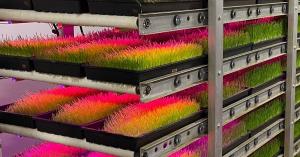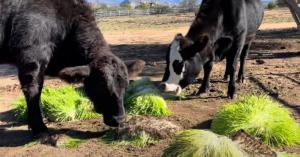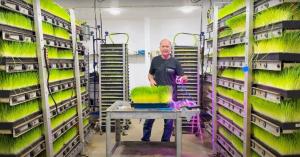Sprouting Gear Introduces Scalable Indoor Farming Tech for Cattle Feed

Hydroponic barley fodder trays under LED grow lights during final-stage development in Sprouting Gear's vertical farming system.
Sprouting Gear’s hydroponic fodder system grows fresh cattle feed in 9 days using minimal water, land, and energy—redefining feedyard efficiency.
“We’ve taken what usually takes land, tractors, irrigation, and weeks—and done it better, faster, and cleaner in a warehouse,” said Paul Pluss, Founder and CEO of Sprouting Gear. “This is the future of livestock feed.”
What Makes It Revolutionary?
Sprouting Gear’s system is engineered for efficiency, resilience, and animal performance. Housed in modular, insulated structures adjacent to feedyards, the system eliminates the need for conventional cropland and dramatically reduces reliance on weather and transportation.
Key Features:
- Grows feed in 9 days from seed to a fully developed barley grass mat
- Three-stage growth chambers optimize germination, sprouting, and greening
- Minimal labor required — fully climate-controlled and semi-automated
- No soil, pesticides, or tractors
- Delivers consistent quality and nutrition year-round, regardless of drought or season
Livestock Benefits:
- Rich in natural probiotics and digestive enzymes
- Improves gut health, feed conversion rates, and immune response
- High moisture content reduces cattle's water demand
- Easily integrated into Total Mixed Ration (TMR) or used as a forage supplement
“Fresh, living feed is biologically active and packed with nutrition in a way dry hay can’t match,” said Pluss. “It’s a superfeed that works alongside traditional rations to boost health and profitability.”
Paul Pluss also contrasts Sprouting Gear’s approach with traditional vertical farming efforts aimed at human food production.
“While vertical farming for produce demands intensive grow lighting for photosynthesis throughout the cycle, our fodder system uses minimal light—and only in the final 4 days,” says Pluss. “On a ton-for-ton basis, growing barley fodder for livestock requires dramatically less lighting energy, often by a factor of 50 to 100 compared to systems growing leafy greens or strawberries.”
Unlike lettuce or strawberry vertical farms that rely on full-spectrum lighting up to 18 hours per day, Sprouting Gear’s design is optimized to minimize electricity use while maximizing output. “I can demonstrate the math,” Pluss adds. “This is why vertical farms for food struggle economically—but our system for feed works.”
Designed for Large-Scale Impact
Sprouting Gear’s system is designed for scalability. By leasing only the number of units needed, ranchers can match their production to the size of their herd. Larger operations can produce hundreds of tons of feed per month while minimizing their environmental footprint and cutting feed transportation costs to zero.
Interested in Building Your Own System?
Sprouting Gear’s licensing model allows ranchers and feedlot operators to build and operate their own production sites with support from Sprouting Gear.
About Sprouting Gear Inc.
Sprouting Gear is a California-based agtech company transforming cattle feeding through its innovative hydroponic fodder system. Designed to reduce land, water, and fuel usage by up to 95%, Sprouting Gear helps livestock producers grow premium feed with unmatched efficiency, consistency, and sustainability.
Learn how to bring vertical feed farming to your operation at: www.sproutinggear.com or contact info@sproutinggear.com
Paul Pluss
Sprouting Gear
info@sproutinggear.com
Visit us on social media:
YouTube
LinkedIn
Instagram
Facebook
From 2 lbs of Seed to 19.4 lbs of Feed – Sprouting Gear’s Latest Results!
Legal Disclaimer:
EIN Presswire provides this news content "as is" without warranty of any kind. We do not accept any responsibility or liability for the accuracy, content, images, videos, licenses, completeness, legality, or reliability of the information contained in this article. If you have any complaints or copyright issues related to this article, kindly contact the author above.


